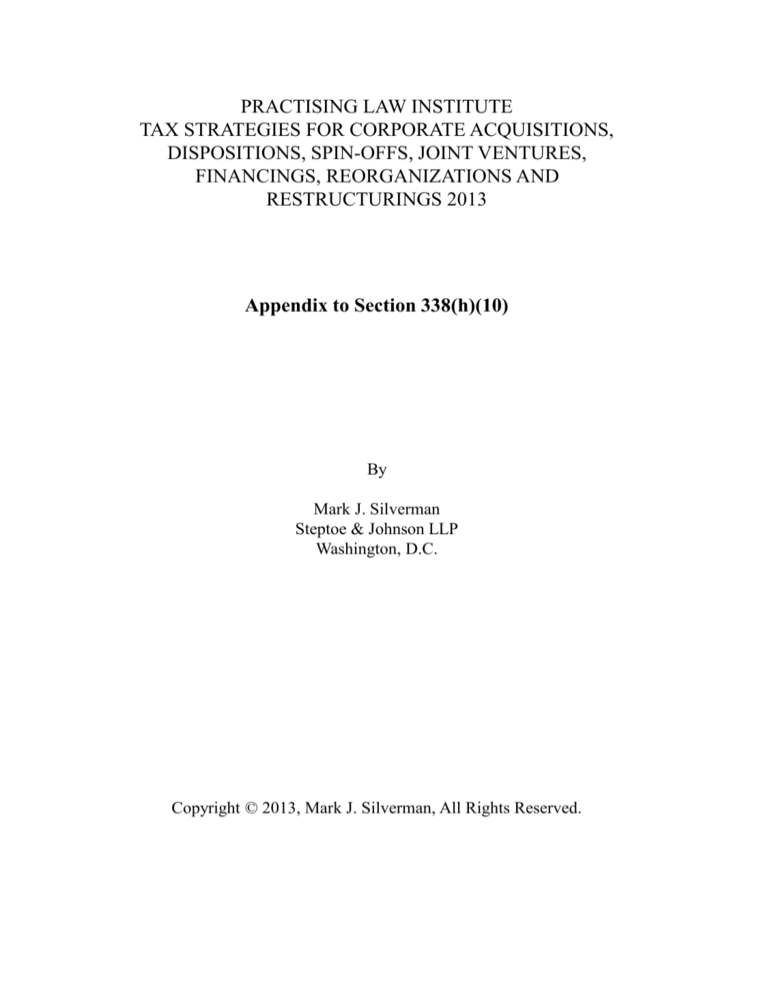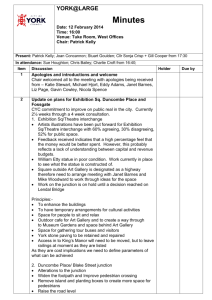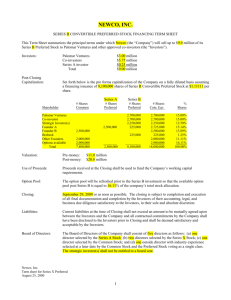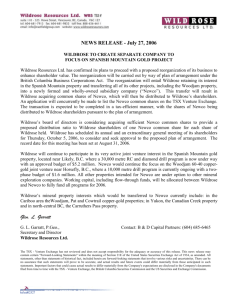
PRACTISING LAW INSTITUTE
TAX STRATEGIES FOR CORPORATE ACQUISITIONS,
DISPOSITIONS, SPIN-OFFS, JOINT VENTURES,
FINANCINGS, REORGANIZATIONS AND
RESTRUCTURINGS 2013
Appendix to Section 338(h)(10)
By
Mark J. Silverman
Steptoe & Johnson LLP
Washington, D.C.
Copyright © 2013, Mark J. Silverman, All Rights Reserved.
Internal Revenue Service Circular 230 Disclosure: As provided
for in IRS regulations, advice (if any) relating to federal taxes
that is contained in this document (including attachments) is not
intended or written to be used, and cannot be used, for the
purpose of (1) avoiding penalties under the Internal Revenue
Code or (2) promoting, marketing or recommending to another
party any plan or arrangement addressed herein.
2
Acquisition with Section 338(h)(10) Election
T Stock
S
P
$
T
S
P
T assets
Old T
New T
$
3
Acquisition Period for Purchases from Related Corps.
1. S owns 100% of the stock of T.
2. On January 1, Year 1, P purchases 30% of the stock of S.
3. On March 1, Year 1, P purchases an additional 30% of the stock of S.
4. On February 1, Year 2, S is liquidated, and P receives 100% of the T
stock in the liquidating distribution.
5. May P make a section 338(h)(10) election with respect to its acquisition
of T?
P
T Stock
100%
60%
S
T
4
Step Transaction Doctrine- Rev. Rul. 2001-46
Situation 1
Step 1
Step 2
T Shareholders
70% P voting
stock and
30% cash
P
P
100%
T
Merge
S
Merge
T
Facts: P owns all of the stock of S, a newly formed wholly owned subsidiary.
Pursuant to an integrated plan, P acquires all of the stock of T, an unrelated
corporation, in a statutory merger of S into T, with T surviving. In the merger,
the T shareholders exchange their stock for consideration of 70% P voting stock
and 30% cash. Immediately thereafter, T merges upstream into P.
Result: If the acquisition were viewed independently from the upstream merger
of T into P, the result should be a QSP of T stock followed by a section 332
liquidation. See Rev. Rul. 90-95, 1990-2 C.B. 67. However, because step
transaction principles apply, see King Enterprises, Inc. v. United States, 418 F.2d
511 (Ct. Cl. 1969), the transaction is treated as a single statutory merger of T into
P under section 368(a)(1)(A). P acquires the T assets with a carry-over basis
under section 362, and P may not make a section 338 election for T.
Note: On July 8, 2003, the Service issued new final and temporary regulations
that permit taxpayers to turn off the step transaction doctrine and to make a
section 338(h)(10) election in the transaction described above. See Treas.
Reg. § 1.338-3(c)(1)(i), (2) and Temp. Treas. Reg. § 1.338(h)(10)-1T.
5
Temp. Treas. Reg. § 1.338(h)(10)-1T(c)(2), (e)
• The new temporary regulations provide that “a section
338(h)(10) election may be made for T where P’s acquisition of T
stock, viewed independently, constitutes a qualified stock
purchase and, after the stock acquisition, T merges or liquidates
into P (or another member of the affiliated group that includes P)
. . . ” Temp. Treas. Reg. § 1.338(h)(10)-1T(c)(2).
• This rule applies regardless of whether, under the step
transaction doctrine, the acquisition of T stock and subsequent
merger or liquidation of T into P (or P affiliate) qualifies as a
reorganization under section 368(a). Id.
• If a section 338(h)(10) election is made under these facts, P’s
acquisition of T stock will be treated as a QSP for all Federal tax
purposes and will not be treated as a reorganization under section
368(a). See Temp. Treas. Reg. § 1.338(h)(10)-1T(e), Ex. 12 &
13.
• However, if taxpayers do not make a section 338(h)(10)
election, Rev. Rul. 2001-46 will continue to apply so as to
recharacterize the transaction as a reorganization under section
368(a). See id. at Ex. 11.
• The regulations are effective for stock acquisitions occurring on
6
or after July 8, 2003.
Step Transaction Doctrine- Rev. Rul. 2001-46
Situation 2
Step 2
Step 1
T Shareholders
100% P voting
stock
P
P
Merge
100%
Merge
T
S
T
Facts: Same facts as in Situation 1, except that the T
shareholders receive solely P stock in exchange for their T stock,
so that the merger of S into T, if viewed independently of the
upstream merger of T into P, would qualify as a reorganization
under section 368(a)(1)(A) by reason of section 368(a)(2)(E).
Result: Step transaction principles apply to treat the transaction
as a merger of T directly into P.
Note: The taxpayers cannot not change this result under the new
section 338 regulations because, standing alone, P’s acquisition
of T does not constitute a qualified stock purchase.
7
Bootstrap Purposes
Redemptions from Unrelated Parties
T stock
S
P
$
40%
60%
$
T
1. On January 1, Year 1, P purchases 60% of the stock of T from B.
2. On June 1, Year 1, T redeems all of the stock of T held by A.
3. June 1, Year 1, is the acquisition date.
8
Bootstrap Purposes
Redemptions from Related Parties
T stock
(2)
$
A
P
$
70%
30%
(1)
T stock
T
1. P owns 30% of the stock of T.
2. On December 15, Year 1, T redeems the T stock held by P.
3. On December 1, Year 2, P purchases the T stock held by A.
4. P has not made a qualified stock purchase of T. The redemption
of P’s T stock is not taken into account.
9
Bootstrap Purchases
Redemptions from Related Persons - Exception
P
T stock
(3)
(1)
60%
$
A
X
$
60%
40%
(2)
T stock
T
1. On January 1, Year 1, P purchases 60% of X Stock.
2. On April 1, Year 1, T redeems X’s T stock.
3. Also on April 1, Year 1, P purchases the T stock held by A.
4. P has made a qualified stock purchases of T on April 1, Year 1.
10
Section 338(h)(10) and “Busted 351” Transaction
P
X
Y
Z
Facts
1. P, X, Y, and Z file a consolidated return.
2. P wishes to sell X and Y to the public and to step up the basis of
the X and Y assets.
11
Section 338(h)(10) and “Busted 351” Transaction Continued
PUBLIC
P
(2)
X&Y
Stock
Z
(1) Newco formed
N
X
Y
12
3. P forms Newco (N) and P transfers the X and Y stock to N.
Pursuant to a prearranged plan, P sells the N stock to the Public.
Section 338(h)(10) and “Busted 351” Transaction Continued
Results
1. The transfer of the X and Y stock to N should not qualify as a section 351
transaction. P is not in control of N immediately after the transfer. See
Rev. Rul. 79-194, 1979-1 C.B. 145; TAM 9747001 (July 1, 1997); PLR
9541039 (July 20, 1995), as modified by PLR 9549036 (Sept. 12, 1995);
PLR 9142013 (July 17, 1991).
2. Thus, N is deemed to purchase the X and Y stock.
3. In this event, P and N can file a section 338(h)(10) election to treat the
transaction as a sale of assets by X and Y followed by section 332
liquidations.
4. The recently issued final regulations contain a similar example. See Treas.
Reg. § 1.338-3(b)(3)(iv), Ex. 1.
5. How much stock does P have to sell?
•
P must sell more than 20% of N stock for section 351 not to a
apply. See section 351(a) and 368(c).
•
P must sell at least 50% of the N stock so that P and N are not
related for purposes of section 338(h)(3)(A)(iii).
•
P must sell more than 80% of the N stock to avoid the application of
the anti-churning rules of section 197(f)(9).
•
Prior to the effective date of recently finalized Treas. Reg. § 1.197-2 it
was possible that the anti-churning rules could have applied even if P
sold all of the N stock because of the momentary relationship between
P and N. See Old Prop. Treas. Reg. § 1.197-2(h)(6)(ii).
13
Section 338(h)(10) and “Busted 351” Transaction Variation
PUBLIC
P
(2)
X&Y
Stock
Z
(1) Newco
formed
N
X
Y
Facts
1. Same as above, except that both P and N sell stock to the public.
Results
1. Does section 351 apply? If so, section 338(h)(10) is not available.
2. Does the answer change if P and N each use different investment
bankers?
14
Intragroup Section 338(h)(10) Election
Example – Recent PLRs
(4)
P Stock
Buy
er
Shareholders
Newco
Common Stock
Cash
(5)
(3)
Newco
Preferred Stock
P
Third-Party
Cash
(1)
T Stock
Busines
sB
(2)
T
Busine
ss A
Newco Stock
– Common
and Preferred
New
co
Busine
ss B
Facts: P is the common parent of a consolidated group. T operates Businesses A
and B. T distributes Business B to P. P forms Newco and transfers the stock of
T to Newco in exchange for Newco common and preferred stock. Pursuant to a
binding obligation, P sells the Newco preferred stock to an unrelated third party.
P distributes all of the Newco common stock to its public shareholders. P’s
shareholders sell their P stock to Buyer.
Result
• Newco’s acquisition of T is a qualified stock purchase under section
338(d)(3). P and Newco are permitted to make an election under section
338(h)(10) with respect to the retained Business A held by T. See PLR
201126003; see also PLRs 201228011, 201203004 and 201145007.
15
PLR 201126003
NewCo
1
Current
preferre
Shareholders
d
interests
Current
Shareholders
3rd Party
Parent
(
4
)
Parent
NewCo 1
common and
preferred
interests
(
1
)
(2
)
Business B, cash,
other properties
Targe
t
NewC
o1
Busine
ss B
New
Co 1
Targe
t
(
4
)
Busine
ss B
Busine
ss A
NewC
o2
NewCo 1
common and
preferred
interests
Busine
ss
New
Co 2
A
Targe
t Sub
NewC
o3
Targe
t Sub
(
3
)
Target
stock
NewCo 1
common and
preferred
interests
New
Co 3
Step 1: Parent will form NewCo 1. NewCo 1 will form NewCo 2. NewCo 2 will form NewCo 3.
The three entities will be formed as LLCs and will elect to be treated as corporations for federal
income tax purposes.
Step 2: Target will distribute cash, Business B and various other properties to Parent. This
distribution is intended to be part of the deemed section 332 liquidation in connection with the
section 338(h)(10) election for Target.
Step 3: NewCo 1 will contribute its common membership interests and preferred membership
interests to NewCo 2. NewCo 2 will contribute the NewCo 1 common and preferred membership
interests to NewCo 3.
Step 4: Parent will transfer 100% of the stock of Target to NewCo 3 in exchange for NewCo 1
common and preferred membership interests. Pursuant to a binding obligation, Parent will 16
transfer
the NewCo preferred interests to an unrelated third party. A section 338(h)(10) election will be
made with respect to the acquisition of the stock of Target.
PLR 201126003
Final
Structure
Current
Shareholders
(6
)
(5
)
Publi
c
NewCo 1
common
interests
$
Paren
Parent
t
Stock
Current
Shareholders
Less than 10%
REIT
New
Co 1
New
Co 1
Parent
New
Co 2
Parent
New
Co 2
Busine
ss B
New
Co 3
Busine
ss B
New
Co 3
REIT
Busine
ss B
Targe
t
Busine
ss A
Targe
t
Busine
ss A
Targe
t Sub
Targe
t Sub
Step 5: Parent will distribute 100% of the NewCo 1 common membership interests to the
Current Shareholders. The distribution is intended to constitute a dividend pursuant to
sections 301 and 316.
Step 6: Current Shareholders will sell their parent stock to REIT and Parent and Business
17 1’s
B will elect REIT status. Upon exercise of an option, REIT may acquire 9.9% of NewCo
common interests from NewCo 1.
PLR 201145007
NewCo
(2)
Investors
Preferred
Stock
Sub 2 –
P
Sub 5
LLC
1
Sub 2
– Sub
5
Sub 6
Sub 7 –
Sub 1
Sub 12
Sub 7
Sub 8
Sub 9
–Sub
12
New
Co
(1)
New
Co
Sub
Facts: Parent was the parent of an affiliated group of corporations filing a life-nonlife
consolidated return that conducted Business A and Business B. Parent owned all of the stock of
Sub 1. Parent also owned (i) all of the interests in LLC1, a disregarded entity that conducted a
part of Business A, and (ii) the stock of Subs 2 through 5. Sub 1 owned (i) all of the outstanding
stock of Sub 6, which conducted the majority of Business A and a portion of Business B; (ii) Sub
7, which conducted a part of Business B and a part of Business A; (iii) Sub 8, which conducted a
part of Business B; and (iv) the stock of Subs 9 through 12.
Parent formed NewCo, which formed NewCo Sub. NewCo issued NewCo common stock and
NewCo preferred stock to NewCo Sub. All assets and liabilities relating to Business A were
transferred and consolidated in S1, LLC1, and Sub 6, and all assets and liabilities relating to
Business B were transferred and consolidated into the remaining applicable Subs.
To separate Business B from Business A, Parent transferred Subs 2 through 5 to NewCo Sub,
and Sub 1 transferred Subs 7 through 12 to NewCo Sub. In exchange, Parent and Sub 1 each
received a pro rata share of the NewCo common and preferred stock held by NewCo Sub.
Parent and Sub 1 immediately sold the NewCo preferred stock to certain investors for cash
pursuant to a preexisting agreement, which Parent used to repay certain indebtedness (Sub 1
18
distributed the cash and NewCo common stock it received to Parent).
PLR 201145007
Acquir
ing
Acquiri
ng
P
New
Co
LLC
1
New
Co
Sub 1
Sub 2
– Sub
5
New
Co
Sub
LLC
1
New
Co
Sub
Sub 6
P
Merge
r Sub
Sub 2
– Sub
5
Sub 7
–Sub
12
Sub 1
Sub 7
–Sub
12
Sub 6
Facts (cont’d): Acquiring formed Merger Sub, which merged with Parent, with Parent surviving. In
the merger, (i) holders of Parent common and preferred stock received NewCo common stock and
cash in exchange for their Parent stock, and (ii) Acquiring's membership interests in Merger Sub
were converted into shares of Parent common stock. Immediately after the Merger, Acquiring
owned 100% of Parent, the investors held all of the NewCo preferred stock, Parent’s former
common and preferred shareholders had received cash and held all of the NewCo common stock,
and neither Parent nor Sub 1 owned any stock in NewCo.
The parties intended to make section 338(h)(10) elections with respect to the transfers of the
subsidiary stock made by Parent and Sub 1 (Subs 2-5 and Subs 7-12, respectively) and with
respect to the deemed transfers of stock of certain direct and indirect subsidiaries owned by such
subsidiaries (Subs 13-39). Parent expected that the deemed asset sales resulting from the section
338(h)(10) elections with respect to the transferred subsidiaries would generate a net ordinary loss,
life insurance company loss from operations, or both, and net capital gain.
19
PLR 201145007
Rulings
• NewCo Sub’s acquisitions of the stock of the subsidiaries transferred
by Parent and Sub 1 qualify as “qualified stock purchases” under
section 338(d)(3), and, assuming a section 338(h)(10) election is
made with respect to its direct shareholder, the deemed sale of the
stock of each of the lower-tiered subsidiaries (Subs 13-39) resulting
from the deemed asset sale of the respective transferred subsidiary
will qualify as a QSP.
• Parent (as the common parent of the selling consolidated group) and
NewCo Sub (by the common parent of its consolidated group) will be
eligible to make section 338(h)(10) elections with respect to such
QSPs.
• Parent’s group will be entitled to deduct in the taxable year ending on
the closing date of the Merger, to the extent otherwise deductible,
losses recognized by the subsidiaries transferred (directly and
indirectly) by Parent and Sub 1 on the deemed sales of their assets.
• Neither NewCo nor NewCo Sub will be a successor to Parent for
purposes of section 1504(a)(3), and NewCo and its direct and indirect
subsidiaries that are includible corporations and that satisfy the
ownership requirements of section 1504(a)(2) will be members of an
affiliated group of corporations entitled to file a consolidated federal
income tax return immediately following the Merger.
20
PLR 201203004
(4)
Public
C Stock
(1)
Newco
(3)
Preferred Stock
Investors
Newco Common/
Preferred Stock
Cash
D
C Stock
T Stock
Newco
(2)
Common
Stock
Newco
S
Busines
sA
T
C
Business B
(Built-in
Losses)
Facts
• D, a publicly-traded corporation, owns all of the stock of S (which operates Business A) and T
(which operates Business B). T’s assets have built-in loss.
• To separate Business A from Business B, D engages in the following steps:
• D forms Newco and transfers the T stock to Newco in exchange for all of the stock in
Newco, which includes common stock and non-voting preferred stock. D and Newco file a
section 338(h)(10) election. D expects to recognize substantial tax losses with respect to the
Business B assets held by T in connection with the contribution to Newco.
• D forms C and contributes all of the Newco common stock to C in exchange for all of the
stock of C.
• D sells all of the Newco non-voting preferred stock to unrelated Investors.
• D distributes all of the C stock to its shareholders (pro rata).
21
PLR 201203004
Public
D
Invest
ors
C
Newco
Common
Busine
ss A
S
Stock
Newc
o
T
Newco
Preferred
Stock
Business
B
Rulings
• D’s transfer of the T stock to Newco is a sale, Newco’s acquisition of T will be a
“qualified stock purchase,” and D and Newco will be eligible to make a section
338(h)(10) election. Section 338(d)(3), (h)(3).
– The transaction is a “busted” section 351 exchange, and thus taxable,
because of D’s sale of the Newco preferred stock. Section 338(h)(3)(A)(i),
(ii).
– No attribution of ownership (section 318(a)) from D to Newco (section
338(h)(3)(A)(iii)), because relatedness is determined immediately after the
spin-off of C. Treas. Reg. § 1.338-3(b)(3) (Stock acquired from a related
corporation is generally not considered acquired by purchase).
– T recognizes built-in loss on deemed asset sale to New T. Treas. Reg. §§
1.338(h)(10)-1(d)(2)-(4).
– T’s loss is taken into account immediately before the spin-off of C. Treas.
Reg. §§ 1.267(f)-1(a)(2), 1.1502-13(d).
22
PLR 201203004
Public
D
Investors
C
Newco
Newco
Preferred
Stock
Common
Busine
ss A
S
Stock
Newco
T
Business
B
Rulings
• D’s contribution to C and its distribution of the C stock qualify as a
“D” reorganization.
– No gain or loss is recognized by D’s shareholders or D on the
distribution of C stock. Sections 355, 361.
– D controls C under section 368(c); it does not matter that C does
not control Newco.
– S’s Business A qualifies as D’s active trade or business (“ATB”),
because S is a member of D’s separate affiliated group (“SAG”).
Section 355(b)(3); Prop. Treas. Reg. § 1.355-3(b)(1)(ii).
– T’s Business B qualifies as C’s ATB (T is a member of C’s
SAG). Section 355(b)(3); Notice 2007-60.
23
Section 304 and Qualified Stock Purchases
Actual Transaction
A
T Stock
P
$
T
1. A owns all the stock of P and T.
2. A sells the T stock to P.
3. A is treated as if A transferred T stock to P for P Stock and then
redeemed the stock it was treated as issuing.
4. P’s basis is determined by reference to A’s adjusted basis. Therefore, P is not
considered to have acquired her stock by purchase.
Recharacterized Transaction
Step 2
Step 1
A
A
T Stock
P Stock
$
P Stock
P
P
T
T
24
Reverse Subsidiary Mergers and QSPs
S
P
N Stock
(1) P Forms N
T
$
N
(2) N Merges into T
1. P forms Newco (“N”) and contributes cash to N in exchange for N Stock.
2. N Merges into T, the T shareholder (S) receives cash for its T stock.
S
P
T
25
Circular Ownership of T Stock
T Stock
S
P
$
60%
T
1. S owns 60% of T stock.
X owns the remaining 40%
of T stock.
100%
40%
2. P purchases the T stock
held by S.
3. Has P made a QSP of T?
X
26
Effect of Post Acquisition Elimination of T
$
S
P
T Stock
T
T1
1. On January 1, Year 1, P makes a QSP of T. On that date T owns the Stock of TI.
2. On March 1, Year 1, T sells the T1 stock to an unrelated corporation.
3. On April 1, Year 1, P makes a section 338 election for T.
P
$
T
X
T1 Stock
27
T1
Treatment of Nonrecently Purchased Stock
90%
S
P
$900
100%
T
1. P purchases 90% of the T stock from S for $900.
2. The parties make a joint section 338(h)(10) election.
What is the grossed-up basis of the T stock?
28
Treatment of Nonrecently Purchased Stock
80%
S
P
$8,000,000
10%
$200,000 basis
90%
T
1. P purchases 80% of the T stock from S within a 12 month
period. P already holds 10% of the T stock with a basis of
$200,000.
2. What is the grossed-up basis of the recently purchased
stock and the nonrecently purchased stock?
29
Determination of ADSP -- Example 1
100%
S
P
$80,000
100%
T
Asset
Basis
FMV
Land
Equipment
$50,000 $75,000
$30,000 $60,000
Liability $40,000
1. What is the ADSP?
30
Determination of ADSP -- Example 2
80%
S
P
$64,000
100%
T
Asset
Basis
FMV
Land
Equipment
$50,000 $75,000
$30,000 $60,000
Liability $40,000
2. What is the ADSP?
31
Determination of ADSP -- Ex. 3: Unrelated Shareholder
80%
K
S
P
$64,000
20%
80%
T
Asset
Basis
FMV
Land
Equipment
$50,000 $75,000
$30,000 $60,000
Liability $40,000
1. What is the impact on K?
32
Determination of ADSP -- Example 4: Target Affiliate
100%
S
P
$80,000
100%
T
Asset
Basis
FMV
Equipment
$30,000 $60,000
Liability $40,000
T1
Land
$50,000 $75,000
33
Acquisition for Cash and Contingent Consideration
T stock
S
P
$50 cash +
$15 note +
earnout
T
Asset
Basis
FMV
Equipment (Class V)
Goodwill (Class VII)
$50
$10
$75
$?
What is the ADSP? How is it allocated?
34
The Distribution of Unwanted Assets
T stock
P
$
S
Bus 2
T1
T
Bus 1
Bus 2
Facts
Corporation S owns all the stock of Corporations T and T1. T operates
businesses 1 and 2. Corporation P is unrelated to S. P wishes to acquire
Business 1 but not any of the other assets owned by S.
Thus, before the effective date of the recently issued final regulations, the following
transactions take place:
• T adopts a plan of complete liquidation.
• T distributes Business 2 to S.
• S sells the T stock to P; S and P make a section 338(h)(10) election.
Questions
1. Does the sale of the T stock qualify for a section 338(h)(10) election?
2. What are the tax consequences of the distribution of Business 2 to S?
3. Does it matter when T’s plan of complete liquidation is adopted? What
if T does not adopt a plan of complete liquidation?
35
The Distribution of Unwanted Assets Continued
S
P
T1
T
Bus 2
Bus 1
4. What would be the result if after the distribution by T of Business 2 to S
and the stock sale by S, S transferred the Business 2 to T1? Would this affect the
deemed liquidation under section 338(h)(10)?
5. What would be the result if it were determined that the deemed liquidation was not
in fact a complete liquidation?
6. What would be the result under the recently issued final regulations?
References
Telephone Answering Service Co. v. Commissioner, 63 T.C. 423 (1974), aff’d
without opinion, 546 F.2d 423 (4th Cir. 1976), cert. denied, 431 U.S. 914 (1977).
Old Treas. Reg. § 1.338(h)(10)-1(e)(2)(ii)
Treas. Reg. § 1.1502-13(j)(2)
New Treas. Reg. § 1.338(h)(10)-1(d)(4)
New Treas. Reg. § 1.338(h)(10)-1(e),Ex.2
PLR 9738031, PLR 9735038, PLR 9210041, PLR 9137040,
36
PLR 9044063, PLR 8938036, PLR 8821047
Application of Section 338(h)(10) to the Purchase of an
Insolvent Corporation -- Insolvent Target Corporation
T stock
S
P
$
T
Assets
1,000,000
Liabilities 1,000,001
Facts
Corporation T owns assets with a value of $1,000,000 and has liabilities of $1,000,001.
P purchases all the stock of T from corporation S for $1 and attempts to make a section
338(h)(10) election with respect to T.
Questions
1. What are the results of this election?
2. Would the results be different under the recently issued final section 338 regulations?
References
Section 338(h)(3)(A)
Treas. Reg. § 1.332-2(b)
New Treas. Reg. § 1.338-3(b)(2)
Rev. Rul. 56-387, 1956-2 C.B. 189
37
Application of Section 338(h)(10) to the Purchase of an
Insolvent Corporation -- Insolvent Target Subsidiary
T stock
S
P
$
T
T1
Assets 10,000,000
Liabilities 6,000,000
T2
Assets
1,000,000
Liabilities 1,000,001
Assets 1,000,000
Liabilities 900,000
T3
Assets
100,000,000
Liabilities 99,900,000
38
Application of Section 338(h)(10) to the Purchase of an Insolvent
Corporation -- Insolvent Target Subsidiary Continued
Facts
Corporation T owns assets with a value of $10 million and has liabilities of $6 million.
Among the assets of T are all of the stock of T1 and T2. The assets of T1 have a value of
$1 million and T1 has liabilities of $900,000. The assets of T2 have a value of $1 million
and T2 has liabilities of $1,000,001. Among the assets of T2 is all of the stock of T3. The
assets of T3 have a value of $100 million and T3 has liabilities of $99,900,000.
P purchases all the stock of T from S and attempts to join with S in a Section 338(h)(10)
election with respect to T, T1, T2 and T3.
Questions
1. What are the results of this election under the old section 338 regulations?
2. Would the result in question 1 be different if T2 had no liabilities, but rather
had outstanding both common and preferred stock, both held by T, with the
preferred stock having a liquidating preference of $1,100,000?
3. Would the results be different under the recently issued final section 338 regulations?
References
Section 338(h)(3)(A)
Old Treas. Reg. § 1.338(h)(10)-1(e)(2)(ii)
Treas. Reg. § 1.332-2(b)
New Treas. Reg. § 1.338-3(b)(2)
New Treas. Reg. § 1.338(h)(10)-1(d)(4)
Rev. Rul. 56-387, 1956-2 C.B. 189
Comm'r v. Spaulding Bakeries, Inc., 252 F2d 693 (2nd Cir. 1958)
H.K. Porter Co. v. Comm'r, 87 TC 689 (1986).
39







